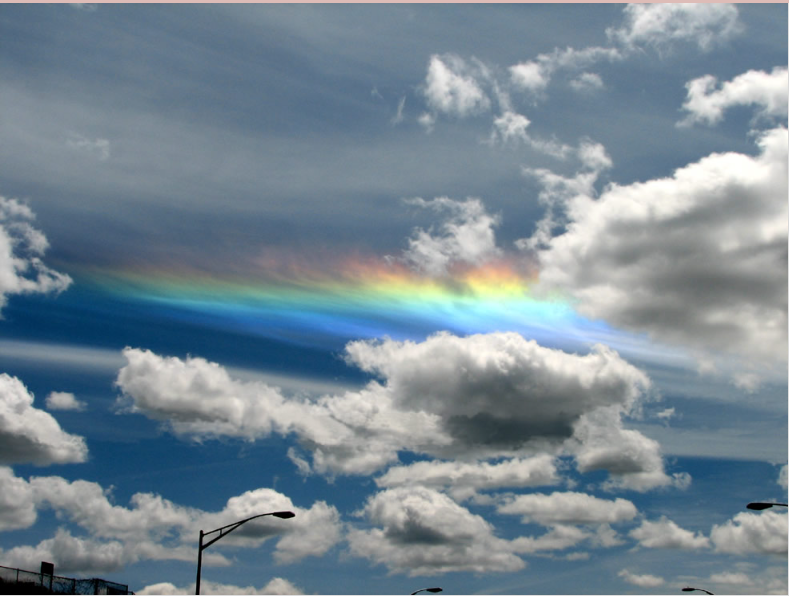Spokane WA Circumhorizon Arc I
The Spectacular Spokane WA Circumhorizon Arc
On June 3, 2006, residents of Spokane, Washington State, were treated to a mesmerizing atmospheric display known as "The Great Spokane halo display." This event, captured in a stunning image by Jonathan Fox, featured a remarkable circumhorizon arc that illuminated the sky with pure prismatic colors. The arc's brightness and extended duration made it a sight to behold and left a lasting impression on those fortunate enough to witness it.
The circumhorizon arc occurs when sunlight passes through ice crystals present in cirrus clouds. These hexagonal crystals act as tiny prisms, refracting and dispersing sunlight into its constituent colors. Unlike rainbows, which are formed by the reflection and refraction of sunlight in raindrops, the circumhorizon arc retains its spectral purity due to minimal rotation of the ice crystals.
The colors of the circumhorizon arc are vivid and vibrant, adding a touch of magic to the sky. From deep reds to vibrant blues and everything in between, the arc paints a breathtaking canvas overhead. The pure spectral hues create a visual feast for the eyes, captivating observers with their brilliance and intensity.
To witness a circumhorizon arc, specific conditions must align. Firstly, cirrus clouds must be present at a particular altitude and orientation. These high-altitude clouds are composed of ice crystals, which are crucial for the formation of the arc. Secondly, the sun must be at a relatively high angle in the sky, typically above 58 degrees. This requirement ensures that sunlight can pass through the ice crystals at an optimal angle for refraction.
The circumhorizon arc appears parallel to the horizon and stretches horizontally across the sky. It is often mistaken for a rainbow due to its vibrant colors and arc-like shape. However, it is essential to distinguish between the two phenomena. While rainbows form when sunlight interacts with water droplets in the atmosphere, circumhorizon arcs are exclusively formed by interactions with ice crystals in cirrus clouds.
One fascinating aspect of the circumhorizon arc is its rarity. The specific combination of atmospheric conditions required for its formation makes it a relatively infrequent occurrence. Therefore, those lucky enough to witness this atmospheric marvel are treated to a truly unique spectacle that may not be seen again for quite some time.
It is worth noting that the circumhorizon arc is just one of several optical phenomena that can grace the sky. Other atmospheric marvels, such as sundogs, halos, and iridescent clouds, add further intrigue to our celestial tapestry. Each of these phenomena is a testament to the intricate and captivating nature of our atmosphere, offering a glimpse into the beauty and complexity of the world around us.
In conclusion, the Spokane WA circumhorizon arc of June 3, 2006, stands as a testament to the awe-inspiring wonders that can unfold in our atmosphere. Its vibrant colors and extended duration made it an unforgettable sight for those who witnessed it. As we continue to explore and appreciate the intricacies of atmospheric optics, let us remain open to the possibility of encountering more breathtaking displays like the Great Spokane halo.

Spokane Washington State, June 3, 2006. "The Great Spokane halo display" was widely seen and will be remembered for the brightness and duration of the arc. Jonathan Fox took this image when the sun was 64° high. The halo lights the cirrus streaks with pure prismatic colours. The circumhorizon and circumzenithal arc colours are hardly smeared by ice crystal rotation and so are spectrally pure, more so than those of the rainbow. Image ©Jonathan Fox, shown with permission.
Note: this article has been automatically converted from the old site and may not appear as intended. You can find the original article here.
Reference Atmospheric Optics
If you use any of the definitions, information, or data presented on Atmospheric Optics, please copy the link or reference below to properly credit us as the reference source. Thank you!
-
<a href="https://atoptics.co.uk/blog/spokane-wa-circumhorizon-arc-i/">Spokane WA Circumhorizon Arc I</a>
-
"Spokane WA Circumhorizon Arc I". Atmospheric Optics. Accessed on November 23, 2024. https://atoptics.co.uk/blog/spokane-wa-circumhorizon-arc-i/.
-
"Spokane WA Circumhorizon Arc I". Atmospheric Optics, https://atoptics.co.uk/blog/spokane-wa-circumhorizon-arc-i/. Accessed 23 November, 2024
-
Spokane WA Circumhorizon Arc I. Atmospheric Optics. Retrieved from https://atoptics.co.uk/blog/spokane-wa-circumhorizon-arc-i/.